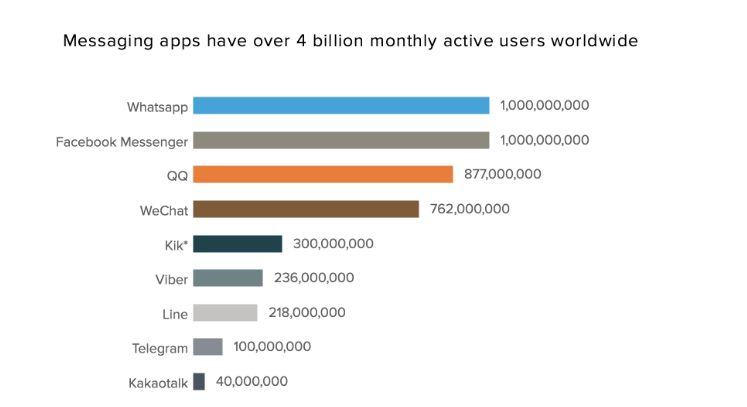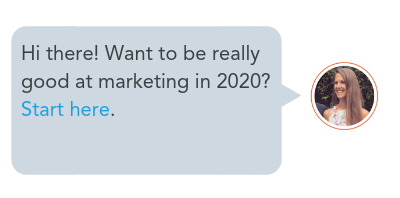Conversations. You wouldn't think they'd need to be so complicated. But somehow when it comes to talking with prospective customers, businesses get all tripped up. We bobble the timing. We totally mis-assess interests. We throw up hoops to in an attempt to "qualify."
We fail again and again to connect buyers with the right person, at the right time. Frankly, we fail to connect with them at all. Although we strive for personalization in our touches, we often create a clumsy, impersonal mess.
Find out how to be really good at Marketing in 2020 here.
It's not that businesses want impersonal communications, but there’s a lot of guesswork when it comes to connecting with prospective buyers at scale. You have to get the person, the timing, the context, and the experience just right.
Advancements in marketing and sales technology have made conversations at scale possible, but often with the side effect of making them less personal. Mass emails and auto-dialing have done serious damage to the vendor-prospect relationship. Despite making headway in delivering more relevant and well-timed communications, lead forms and marketing automation have yet to truly bridge the gap of creating a one-to-one conversational experience.
But those limitations are starting to shift. Before we dive into what’s becoming possible now, let’s take a look at how consumer behaviors and expectations have changed over the last few years.
Identification Isn't as Simple as a Phone Number or Email Anymore
Businesses have been trying to get to a place where they can treat a person like a person for a long time. With limited context, however, businesses often over-index for the thing that gives them access to the person rather than for the person herself.
In the days of cold calling, this boiled down to the phone number. Sales reps would do everything possible to get a list of phone numbers, then smile and dial their way down the page to turn those phone numbers into connections. But the problem with treating a phone number as a “contact” is that phone numbers come with no context on the person behind them -- and result in uninvited and poorly timed calls.
Marketing software tried to address this context problem by creating a way for prospective buyers to request information and provide additional detail on their timing and interests through forms. In the era of marketing automation, email addresses became the new de facto contact identifier.
However, while this method does add context to make communications more relevant, email will always be an asynchronous and less efficient form of communication than true, real time conversations.

The problem with both phone numbers and email addresses as identifiers is multifold:
- They can be bought and sold unscrupulously.
- They are still just a proxy for identity -- not identity itself.
- Increasingly, there is no one at the other end of them.
Today, connecting with prospects is still listed as the hardest part of selling by sales reps. In offices all over the world, desk phones are going away, inboxes are getting better at filtering out uninvited or irrelevant emails and the role of starting the conversation is moving from the marketer or salesperson to the prospective buyer.
In addition, people are adopting new channels for communication at a breakneck pace. Today more than 4 billion people use messaging apps every month to talk with friends and businesses alike. And thankfully there's simply no way to purchase a list of messaging users.

These changes are all positive for any company that cares about the customer experience. However, they also mean that businesses will need to offer live chat to make sure those prospective customer conversations don’t go unanswered.
Timing Has Moved From Asynchronous to Instantaneous
"Is now a good time to talk?"
" ... How about now?"
"Do you have 15 minutes this week to connect?"
If you're a salesperson, you've undoubtedly used one of the questions above or a variation in your prospect communication. Unfortunately, the answers are almost always "no".
It's not that people are actually busier than they used to be. It's that the act of scheduling time to have a conversation is becoming passe. Buyers control their own schedules. They want information when they need it and only then.
This affects prospect conversations in a handful of distinct ways. For starters, there are no more standard working hours. Whether you're selling locally or globally, business can happen at any point -- 5 p.m. or 4 a.m. -- around the clock. If you're trying to squeeze all of your conversations into eight fixed hours, you are going to miss opportunities.
In addition to expanded query hours, consumer-grade artificial intelligence is priming buyers to expect instantaneous answers. Ask Siri or Alexa for the weather outside and she'll tell you, just like that. Search for information on Google and in 30% of the cases, the search engine will now provide a quick answer box rather than just a list of links to follow.
This isn’t just on-demand information, however, it’s also “as needed.” Increasingly, seekers can get information the moment they need it without even having to ask.
If you operate in any sort of routine day-to-day, you’re probably most familiar with this experience through Google Maps. As Maps learns your habits, it will start predicting your next move and providing helpful information to match it. Step outside your office at the end of a typical workday and Google will alert you to the traffic conditions and travel time to your home. This kind of prediction feels jarring the first few times it happens, but after some recurrence becomes engrained in daily experience and codified as an expectation.
In all of these examples, one thing is clear: Scheduling conversations for a future date and waiting for answers from businesses is becoming less necessary.

The Implications of These Changes for Business-Buyer Communication
Technology is getting better at stripping down the barriers to more personal communications at scale. In the age of direct dials, businesses would go into conversations completely cold, lacking any information about what mattered to the prospective customer (or whether they were in the mindset to have the conversation to begin with). Then, with the advent of landing pages and marketing automation, prospects gained more control, providing businesses with more cues as to their timing and areas of interests.
Today, that exchange of information can happen at a much faster pace. More and more, information gathering about a prospect's timing and interests happens behind the scenes in ongoing and unstructured ways. For example, a single conversational chat with a prospect via a messaging app can generate scores of data points to make future conversations more relevant without the formality of field submissions.
 As technology gets better at recognizing patterns and extracting data behind the scenes, conversations will ironically become less robotic and more human. And this is something businesses of all sizes can appreciate.
As technology gets better at recognizing patterns and extracting data behind the scenes, conversations will ironically become less robotic and more human. And this is something businesses of all sizes can appreciate.










